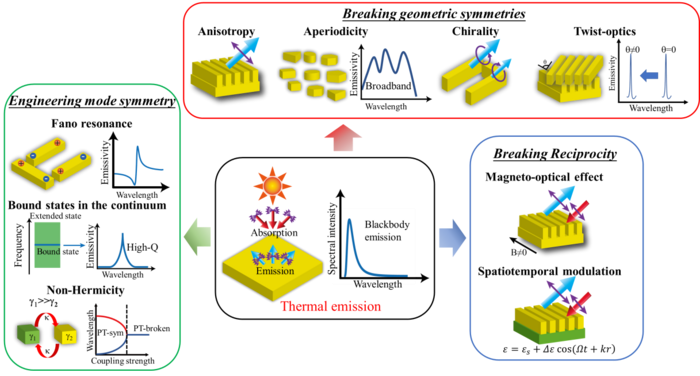Radiative heat transfer is a universal physical phenomenon. Any object with a temperature over absolute zero tends to exchange thermal energy with its surroundings.

The review paper overviewed three categories of broken symmetries: breaking geometric symmetries, engineering mode symmetry, and breaking reciprocity. Image Credit: Tianji Liu, Cheng Guo, Wei Li, and Shanhui Fan.
In the field of physics, thermal emission comes from electromagnetic radiation, prompted by the thermal motion of charged particles within materials. Planck’s law defines the spectral dispersal of emitted power. The second law of thermodynamics rules the irreversibility of energy transfer in thermal emissions.
Thermal emission is usually broadband, omnidirectional, incoherent, and unpolarized. That is because of fluctuating electromagnetic fields thermally produced within materials.
The fast development of nanophotonics has enabled scientists to show that thermal emission, akin to spontaneous light emission, can be manipulated or engineered. It can be made using naturally or artificially occurring micro/nanostructures.
Narrowband, directional, or polarized thermal emissions are all projected and experimentally shown with the help of metamaterials. Productive achievements push the development of thermal photonics, enhancing the efficiency of energy utilization and transforming numerous energy applications.
In a new article reported in the journal eLight, a joint group of researchers from Stanford University and Changchun Institute of Optics, Fine Mechanics and Physics, Chinese Academy of Sciences, guided by Prof. Shanhui Fan and Prof. Wei Li, stressed the significance of broken symmetries for the nanophotonic regulation of thermal emissions and reviewed numerous physical phenomena and associated applications.
Symmetries are of major significance in physics. A system’s symmetry is a physical characteristic that stays invariant under certain transformations. The transformations may be discrete or continuous, which produces analogous types of symmetries.
Continuous symmetries are illustrated by Lie groups, while finite groups illustrate discrete symmetries. The continuous symmetries of a physical system are closely associated with the conservation laws defining that system.
Symmetries also have a significant role to play in thermal radiation. In this scenario, the applicable symmetries include geometric and non-geometric types. These symmetries have crucial effects on thermal radiation.
For example, any thermal emitter is defined by two core quantities: the angular spectral emissivity and the angular spectral absorptivity. It is said that the presence of geometric and non-geometric symmetries executes direct constraints. On the contrary, breaking these symmetries can eliminate such constraints.
As a basic but crucial example, the scientists observed that any linear time-invariant thermal emitter requires to be lossy. Therefore, they have to interrupt energy conservation and time-reversal symmetry. However, it can either disrupt or obey Lorentz reciprocity.
In summary, the scientists inspected engineered nanophotonic structures with broken symmetries in thermal photonics, mostly focusing on regulating thermal emission. They are diverse from conventional materials and nanophotonic structures possessing high symmetries. Broken geometrical symmetries are deliberated, including chirality, randomness, aperiodicity, and anisotropy.
This was a chance to emphasize the geometrical asymmetry-prompted control of thermal emission and other thermal effects. Further symmetry-breaking can be achieved through developing various mode symmetries, and unusual nanophotonic states, including Fano resonance and bound states in the continuum, are also viable for the control of thermal emission. It allows narrowband emission and total switching of thermal emission.
Reciprocity is a central internal symmetry in electromagnetics. Breaking reciprocity in thermal photonics causes nonreciprocal thermal emission, which can disrupt Kirchhoff’s law of thermal radiation and may enhance energy conversion efficiency and harvesting applications.
It achieves this by manipulating the magneto-optical effect and spatiotemporal modulation. For further development, adding more compound broken symmetries and investigating the asymmetries in light-matter interactions may offer new study opportunities.
Furthermore, the researchers momentarily deliberated on a few upcoming directions: the non-Hermitian system and twist-optics.
Journal Reference:
Liu, T., et al. (2022) Thermal photonics with broken symmetries. eLight. doi.org/10.1186/s43593-022-00025-z.